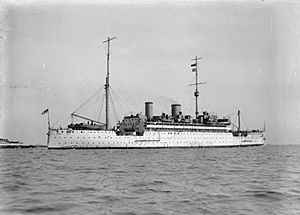HMS Medway (1928) facts for kids

Medway at anchor
|
|
Quick facts for kids History |
|
|---|---|
| Name | HMS Medway |
| Namesake | River Medway |
| Ordered | 14 September 1926 |
| Builder | Vickers Armstrong, Barrow-in-Furness |
| Laid down | April 1927 |
| Launched | 19 July 1928 |
| Completed | 3 July 1929 |
| Identification | Pennant number: 25 |
| Fate | Sunk by U-372, 30 June 1942 |
| General characteristics | |
| Displacement | |
| Length | 580 ft (176.8 m) (o/a) |
| Beam | 85 ft (25.9 m) |
| Draught | 21 ft 3 in (6.5 m) |
| Installed power | 8,000 bhp (6,000 kW) |
| Propulsion | 2 shafts, MAN diesel engines |
| Speed | 15 knots (28 km/h; 17 mph) |
| Complement | 400 + 1,335 (spare) |
| Armament |
|
| Armour |
|
HMS Medway (Pennant F25) was a special ship built for the Royal Navy. She was the very first ship designed just to support submarines. Think of her as a floating home and repair shop for submarines! She was built by Vickers Armstrong in Barrow-in-Furness in the late 1920s.
Before World War II, Medway served in Asia, at a place called the China Station. Later, in 1940, she moved to Egypt. In May 1942, during the war, German forces were getting close to Alexandria, Egypt. So, Medway was told to leave. She sailed for Lebanon at the end of June, with a light cruiser and seven destroyers protecting her. But even with this strong escort, she was sunk on June 30, 1942, by a German submarine.
Contents
Building a Submarine Support Ship
Medway was designed to help many submarines at once. She could support up to 18 submarines during peacetime. She also carried extra torpedoes and spare deck guns for them.
The ship was quite large. She was 580 feet (176.8 m) long, which is longer than a football field! Her beam (width) was 85 feet 1 inch (25.9 m). When fully loaded, she weighed about 18,362 long tons (18,657 t) (long tons).
Medway had a crew of 400 officers and sailors. She could also hold an extra 1,335 people, like submarine crews who were resting or waiting for their submarines to be repaired.
How Medway Moved
The ship was powered by MAN diesel engines. These engines gave her 8,000 brake horsepower (6,000 kW) of power. This allowed her to reach a top speed of about 15 knots (28 km/h; 17 mph) (knots). She carried a lot of diesel fuel, not just for herself, but also 1,880 long tons (1,910 t) to refuel her submarines.
Medway also had five large generators. These made electricity for the ship and had special equipment to recharge submarine batteries.
Ship's Defenses
For protection, Medway had several guns. She had two 4-inch (102 mm) guns and four quick-firing 4-inch anti-aircraft guns. These anti-aircraft guns were used to shoot down enemy planes.
The ship also had special armor. She had an internal anti-torpedo bulge. This was a protective layer designed to absorb the impact of a torpedo and stop it from sinking the ship.
Building Timeline
The order to build Medway was placed on September 14, 1926. Her construction started in April 1927 at the Vickers Armstrong shipyard. She was launched into the water on July 19, 1928. Captain Colin Cantlie became her first commander in January 1929. The ship was officially finished on July 3, 1929.
After being built, Medway went through tests. These were called Harbour Acceptance Trials (HATs) and Sea Acceptance Trials (SATs). These tests made sure everything on the ship worked correctly.
Medway's Service and Sinking
HMS Medway spent time on the China Station before World War II began. She took over from another ship, HMS Titania, in 1929/30. Medway became the main support ship for the 4th Submarine Flotilla in Hong Kong.
Under Captain Colin Cantlie, Medway sailed to Hong Kong with six O-Class submarines. These submarines were:
- HMS Odin (N84)
- HMS Olympus (N35)
- HMS Osiris (N67)
- HMS Orpheus (N46)
- HMS Oswald (N58)
- HMS Otus (N92)
The group of submarines she supported grew even larger in 1930.
Wartime Service
From September 1939 to February 1940, Medway was repaired and updated in Singapore. After this, she went back to Hong Kong. On April 2, 1940, she left Hong Kong and sailed to Alexandria, Egypt. She arrived there on May 3 and began supporting the 1st Submarine Flotilla. This group of submarines operated in the eastern part of the Mediterranean Sea.
Two years later, in June 1942, Vice-Admiral Henry Harwood ordered all ships that weren't absolutely needed to leave Alexandria. This was because German forces were advancing, and he wanted to prevent them from capturing the port facilities.
Medway loaded supplies and 1,135 people on June 29. They planned to set up a new base in Beirut, Lebanon. She sailed later that day, escorted by the light cruiser Dido and seven destroyers.
The Sinking
The very next day, off Port Said, a German submarine called U-372 fired two torpedoes. These torpedoes hit and sank Medway. Sadly, 30 men lost their lives in the sinking.
Even after the ship sank, 47 of the 90 spare torpedoes she carried floated free. These were later collected and used by other ships.
See also
- Submarine depot ships
- HMS Ambrose (1903)
- HMS Hazard (1894)
- HMS Cyclops (F31)
- HMS Titania (1915)

